
Eurovox is a congress organized by the European Voice Teachers Association (EVTA) every third year and focuses on various aspects of human singing. Therefore it gathers 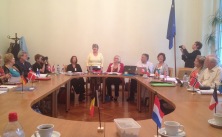 professional and amateur singers, their teachers, scientists, physicians and other enthusiasts of the voice all together. I represented Belgium,being the vice president of Evta-Be and thus member of the council of EVTA.
professional and amateur singers, their teachers, scientists, physicians and other enthusiasts of the voice all together. I represented Belgium,being the vice president of Evta-Be and thus member of the council of EVTA.
THURSDAY JUNE 18TH
Kristin Linklater – Training the speaking voice for this century: Old traditions and new communication
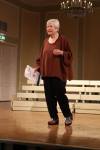 After the EVTA council meeting and a beautiful opening concert, the keynote speaker of Thursday was Kristin Linklater. As I have done some workshops with voice teachers who have been trained by this grand lady of voice herself, I was very curious. During her inspirational speech, she spoke about the importance of human emotions and the heart in a time of avatars and robotics. Her philosophy about working on the voice is that it is a commitment to hold a mirror up to human nature. It is looking for freedom. Freeing the natural voice is looking for nature before the nurture into fears.
After the EVTA council meeting and a beautiful opening concert, the keynote speaker of Thursday was Kristin Linklater. As I have done some workshops with voice teachers who have been trained by this grand lady of voice herself, I was very curious. During her inspirational speech, she spoke about the importance of human emotions and the heart in a time of avatars and robotics. Her philosophy about working on the voice is that it is a commitment to hold a mirror up to human nature. It is looking for freedom. Freeing the natural voice is looking for nature before the nurture into fears.
This lecture made me look forward to the workshop of Friday.
Dr. Joseph Quoidbach – How a posturoacoustic laboratory can help singers
 As dr. Quoidbach has been keynote speaker during the conference of our own Evta-Be in 2012, I already knew what was coming. Joseph does very interesting work with his posturoacoustic laboratory at IMEP Namur in Belgium. He works with the voice students of this conservatory on the relation of body posture and the formants of the voice. His aim is for the singer to “be straight, but free”. The student receives manual therapy and learns in the laboratory which posture is ideal for the best sound to be created. This posture is recorded with the kinect (a camera that you might know from the Wii) and a mat that measures the position of the feet. Simultaneously, the singer can see visual feedback of the sound with a spectrogram and a power spectrum.
As dr. Quoidbach has been keynote speaker during the conference of our own Evta-Be in 2012, I already knew what was coming. Joseph does very interesting work with his posturoacoustic laboratory at IMEP Namur in Belgium. He works with the voice students of this conservatory on the relation of body posture and the formants of the voice. His aim is for the singer to “be straight, but free”. The student receives manual therapy and learns in the laboratory which posture is ideal for the best sound to be created. This posture is recorded with the kinect (a camera that you might know from the Wii) and a mat that measures the position of the feet. Simultaneously, the singer can see visual feedback of the sound with a spectrogram and a power spectrum.
 Now the singer can practice to imitate that ideal posture with mirrors, the kinect and footmat. The results are quite striking. Jodie Devos, one of the singers dr. Quoidbach is working with, together with her voice teachers, has won the 2nd price at the Queen Elisabeth contest of 2014! I have had the honor to have a taste of the laboratory myself in 2012 and was immediately convinced of the valuable possibilities this way of working offers.
Now the singer can practice to imitate that ideal posture with mirrors, the kinect and footmat. The results are quite striking. Jodie Devos, one of the singers dr. Quoidbach is working with, together with her voice teachers, has won the 2nd price at the Queen Elisabeth contest of 2014! I have had the honor to have a taste of the laboratory myself in 2012 and was immediately convinced of the valuable possibilities this way of working offers.
Pedro de Alcantara – Six exercises for the integration of body and mind
Besides being fun, the exercises of Pedro De Alcantara made us aware of the fact that we are responsible for the way we enter a situation. We can choose how to play the game. Whether it be a simple conversation or a singing contest.
Gillyanne Kayes & Jeremy Fisher – Style and comfort in multi-genre teaching, part 1
Gillyanne and Jeremy gave us an introduction to their method Vocal Process.  What I really like about their philosophy is their basic question: What does THIS singer need to sing THIS song in THISstyle? They don’t judge whether what the singers wants to do is “good” or “bad”. It suits my own personal belief that the artistic preference of a voice teacher doesn’t matter. We are at service of what the singers want and need. Our only job is to help them reach their goal in a healthy way.
What I really like about their philosophy is their basic question: What does THIS singer need to sing THIS song in THISstyle? They don’t judge whether what the singers wants to do is “good” or “bad”. It suits my own personal belief that the artistic preference of a voice teacher doesn’t matter. We are at service of what the singers want and need. Our only job is to help them reach their goal in a healthy way.
The singer = Voice type & weight, energy, range, comfort zone, ‘defaults’,…
The song = Style, energy, sound, note articulation, phrasing, purpose,…
Gillyanne and Jeremy deconstruct the vocal  setting of the singer by trying to speak or sing in the voice of the singer and question how it feels, sounds and looks. They focus on use of the voice, articulation, vocal idioms (onsets & offsets) and the use of breath.
setting of the singer by trying to speak or sing in the voice of the singer and question how it feels, sounds and looks. They focus on use of the voice, articulation, vocal idioms (onsets & offsets) and the use of breath.
They combine this knowledge with the specific requirements for the genre of the song (range, register mechanism, style elements,…).
Dr. Ilter Denizoglu – Multidimensional aspects of human voice production: Anatomy and physiology from the standpoint of arts, mathematics and sound physics
 I would like to start with the conclusion of this lecture: ‘It is necessary to know something of every discipline in order to understand the whole picture.’ I could not agree more! A holistic approach to the voice (in fact to everything in life) is something I personally try to promote wholeheartedly.
I would like to start with the conclusion of this lecture: ‘It is necessary to know something of every discipline in order to understand the whole picture.’ I could not agree more! A holistic approach to the voice (in fact to everything in life) is something I personally try to promote wholeheartedly.
Dr. Denizoglu started out with explaining the source-filter theory and used the technique of ‘chiaroscuro’ from the Italian art of Bel Canto (beautiful singing) to illustrate this. The ‘squillo’ – nowadays referred to as twang – is a  narrowing of the aryepiglottic funnel that produces a brilliant sound. This creates the so called ‘singers formant’, where the frequency of 3000 HZ is being amplified. We can pick up this frequency very well, as it is the natural frequency of the human outer ear canal. It is not a coincidence that babies use a lot of twang / squillo! This is a little tidbit of my part: This frequency is not used by symphonic orchestral instruments, so that is why a classical singer can be heard above an orchestra… Because of the singers formant ;o) In chiaroscuro, the squillo is combined with ‘scuro’, the dark, warm sound that is attained by lowering the larynx, which increases the resonating volume.
narrowing of the aryepiglottic funnel that produces a brilliant sound. This creates the so called ‘singers formant’, where the frequency of 3000 HZ is being amplified. We can pick up this frequency very well, as it is the natural frequency of the human outer ear canal. It is not a coincidence that babies use a lot of twang / squillo! This is a little tidbit of my part: This frequency is not used by symphonic orchestral instruments, so that is why a classical singer can be heard above an orchestra… Because of the singers formant ;o) In chiaroscuro, the squillo is combined with ‘scuro’, the dark, warm sound that is attained by lowering the larynx, which increases the resonating volume.
Leonardo Da Vinci said ‘The artist who knows the nature of the muscles and cords, knows how they give motion to the organs and extremities’. Inspired by this quote, dr. Denizogly states that it is important for a singer to understand the muscle mechanisms of sound color, in order to be able to avoid a break between the registers (passagio).
FRIDAY JUNE 19TH
Pedro de Alcantara – Warm Up Even though I am familiar with and a fan of Alexander technique, and liked the exercises Pedro did with us on Friday, this warm-up didn’t do much for me.
Even though I am familiar with and a fan of Alexander technique, and liked the exercises Pedro did with us on Friday, this warm-up didn’t do much for me.
Dr. Ilter Denizoglu – Scientific secrets of breathing for singing
 Inhalation and breath support… For centuries, it has been the subject of discussion. Luckily, nowadays, we are able to understand our instrument much better, thanks to the newest scanners and suchlike.
Inhalation and breath support… For centuries, it has been the subject of discussion. Luckily, nowadays, we are able to understand our instrument much better, thanks to the newest scanners and suchlike.
Dr. Denizoglu explained to us the physical interactions between the voice and the breath. The transglottic airflow sets the vocal fold mucosa in motion (Voice = subglottic pressure + glottic resistance). In fact, we can explain the voice by the production of energy (inhalation) and the transformation of it (kinetic energy – vocal fold vibration). These physioanatomic insight are translated into vocal pedagogy.
 Obviously, the posture has an important effect on these mechanisms. The sternothyroid muscle is the active link between breathing in (sternum) and voice production (larynx – thyroid). Keeping the sternum high separates the extrinsic laryngeal muscles from the breathing process and prevents a breath that is too high. A good posture also helps to achieve the important passive intake of breath by avoiding the use of secondary breathing muscles. As they are also the laryngeal suspension muscles, it’s important to separate the respiration from phonation.
Obviously, the posture has an important effect on these mechanisms. The sternothyroid muscle is the active link between breathing in (sternum) and voice production (larynx – thyroid). Keeping the sternum high separates the extrinsic laryngeal muscles from the breathing process and prevents a breath that is too high. A good posture also helps to achieve the important passive intake of breath by avoiding the use of secondary breathing muscles. As they are also the laryngeal suspension muscles, it’s important to separate the respiration from phonation.
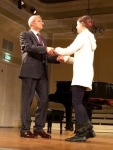 Breath support is slowing down the elevation of the diaphragm, and thus controlling the subglottal pressure, by balancing the contradiction by certain posture muscles (e.g. psoas muscle) & controlling the diaphragm by itself. I personally use the term ‘inhalare la voce’ – sing as if you breathe in – a lot in my coaching practice.
Breath support is slowing down the elevation of the diaphragm, and thus controlling the subglottal pressure, by balancing the contradiction by certain posture muscles (e.g. psoas muscle) & controlling the diaphragm by itself. I personally use the term ‘inhalare la voce’ – sing as if you breathe in – a lot in my coaching practice.
Dr. Denizoglu ended the presentation with the question how much air we must breathe in. The airflow during phonation is related to the phonation style, volume, pitch, shape of the vocal tract, consonant, singing style & training. In short, it’s important not to over-breathe. We need to be able to control the ‘wild air’.
I personally liked both lectures by dr. Denizoglu and am very happy that he will be giving a workshop and lecture during the symposium of Evta-Be, this fall. I regret however, that the way he gave the lectures, made me (and some of my colleagues) feel that he believes that the principles of Bel Canto are the only existing healthy singing techniques.
Kristin Linklater – Freeing the natural voice
 ‘Yes, the voice is a musical instrument, but it is above all a human instrument. It comes from your thoughts, your feelings, your emotions. We sing, because speaking is no longer enough.’ Inspirational workshop! Just what I needed. Now I was no longer sorry that I had missed my weekly Friday morning yoga class ;o)
‘Yes, the voice is a musical instrument, but it is above all a human instrument. It comes from your thoughts, your feelings, your emotions. We sing, because speaking is no longer enough.’ Inspirational workshop! Just what I needed. Now I was no longer sorry that I had missed my weekly Friday morning yoga class ;o)
Penelope Price-Jones – Pathways: A new teacher training course in the UK
&
Eleanor Forbes & Bettina Kerth – Continuing education opportunities for singing teachers in Germany
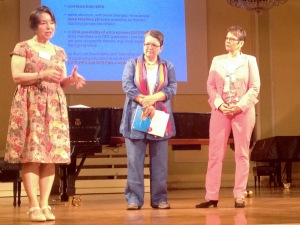 AOTOS, the Association of Teachers of Singing, organizes a professional development course for practising singing teachers and people who are starting to teach. Click here and here to read more on the content.
AOTOS, the Association of Teachers of Singing, organizes a professional development course for practising singing teachers and people who are starting to teach. Click here and here to read more on the content.
A lot of people start teaching after a long career as a professional singer, where they have achieved a lot of valuable experience. Unfortunately, they often lack some necessary knowledge and skills, such as anatomy, vocal development, pedagogy, didactics, music theory, keyboard skills, repertoire,… AOTOS offers them a mixture of practical and theoretical training in order to ‘fill the gaps’.
BDG, the Bundesverband Deutcher Gesangspädagogen offers GPZ, a similar initiative in Germany. A lot of student-teachers feel that they are not being well prepared for teaching. They especially need more contact hours during their years at the university / conservatory. The changed structures into bachelor & master degrees resulted in the loss of a lot of courses in the training of performers. Amongst them pedagogy. GPZ offers those people a thorough training and certificate, which is very much in demand in Germany.
The profession of ‘voice teacher’ & ‘vocal coach’ is not protected. My colleague vocal coaches must recognize my own personal frustration about that. A lot of teachers need and actively look for ongoing education and mentoring. As it should be! I like to compare ourselves to doctors, who also should know the latest developments in medicine and health care. Consequently, I applaud initiatives like those from AOTOS and BDG. I find them a truly inspiring example for voice teachers associations all over the world.
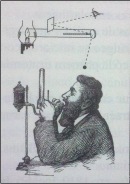 A bit of interesting history to end the report on this lecture… In earlier days, teachers were trained in a vertical way (master – pupil). There was also a big division between ‘Stimmbilder’ (science) and singing teachers (art). Science looked down on art, as ‘they didn’t know enough about vocal physiology’. Manuel Patricio Rodríguez García, a former professional singer & teacher at the Royal Academy of Music of London, invented the laryngoscope in 1854. He passed his findings on to other voice teachers. Franziska Martienssen-Lohmann & Paul Lohmann combined anatomical knowledge and singing tradition in Die geistige Klangvorstellung, Der Wissende Sänger, lectures, courses and masterclasses for both performers and voice teachers. This resulted in constructive discussions and a more horizontal relationship between teachers and singers.
A bit of interesting history to end the report on this lecture… In earlier days, teachers were trained in a vertical way (master – pupil). There was also a big division between ‘Stimmbilder’ (science) and singing teachers (art). Science looked down on art, as ‘they didn’t know enough about vocal physiology’. Manuel Patricio Rodríguez García, a former professional singer & teacher at the Royal Academy of Music of London, invented the laryngoscope in 1854. He passed his findings on to other voice teachers. Franziska Martienssen-Lohmann & Paul Lohmann combined anatomical knowledge and singing tradition in Die geistige Klangvorstellung, Der Wissende Sänger, lectures, courses and masterclasses for both performers and voice teachers. This resulted in constructive discussions and a more horizontal relationship between teachers and singers.
The first international Congress of Voice Teachers (1987, Strasbourg) gathered voice teachers, ENT specialists and other voice specialists. The key words were ‘international’, ‘interdisciplinary’ and ‘influential’. The European Voice Teachers Association is a direct result of this conference, which may be called a milestone!
Pilar Lirio – Scientific methodology for singing teachers: Parameters, software, statistics, etc.
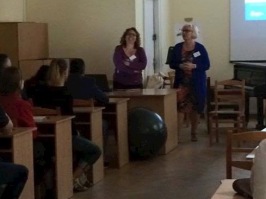 As more and more singing teachers (like myself) are performing scientific research, an introduction to the ‘how to’s’ and possible pitfalls can be very useful. Pilar Lirio is a voice researcher herself and presented a lecture on it on Saturday, which I didn’t attend, as lectures were happening simultaneously.
As more and more singing teachers (like myself) are performing scientific research, an introduction to the ‘how to’s’ and possible pitfalls can be very useful. Pilar Lirio is a voice researcher herself and presented a lecture on it on Saturday, which I didn’t attend, as lectures were happening simultaneously.
This lecture on Friday was quite chaotic and confusing, something I attribute to the fact that maybe the presentation was designed for a much longer lecture. I was happy to receive the pdf of the presentation afterwards (thank you, Pilar!), because it turned out to be an interesting document.
Gillyanne Kayes & Jeremy Fisher – Style and comfort in multi-genre teaching (Masterclass)
 During this masterclass, Gillyanne and Jeremy coached three singers from the YPP Program (classical, jazz & rhythmical), in order to illustrate their concept they had already presented on Thursday. They focused on technique, performance, story telling and posture.
During this masterclass, Gillyanne and Jeremy coached three singers from the YPP Program (classical, jazz & rhythmical), in order to illustrate their concept they had already presented on Thursday. They focused on technique, performance, story telling and posture.
I especially liked the exercise that combined posture & story.
The singer stands with one foot a bit more to the front.
– Weight divided over both feet = neutral, uninvolved, solid,…
– Weight more on the front foot = engaging, aggressive,…
– Weight more on the back foot = secretive, relaxed, thoughtful,…
– Contrapost pose = ‘Don’t mess with me’
First, the singer decides which pose to take. Afterwards, the teacher ‘pushes’ and the singer has to follow. Interesting results!
Ineke Vandoorn – From the inside out: Teaching pop & jazz singing
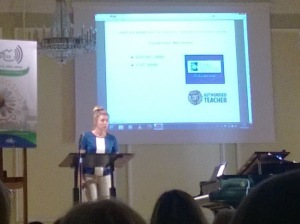 I had been looking forward to this lecture, as I personally believe we need more presentations like this on pop and jazz singing! Ineke Van Doorn is the first singer that graduated from a Dutch conservatory with a degree in Jazz singing. Being a singing teacher since 1985, she has gained a lot of valuable knowledge and skills, which she has brought together in her book Professioneel zingen voor iedereen (Singing professionally for everybody). She presented her concept and some of her ideas, which I enjoyed a lot.
I had been looking forward to this lecture, as I personally believe we need more presentations like this on pop and jazz singing! Ineke Van Doorn is the first singer that graduated from a Dutch conservatory with a degree in Jazz singing. Being a singing teacher since 1985, she has gained a lot of valuable knowledge and skills, which she has brought together in her book Professioneel zingen voor iedereen (Singing professionally for everybody). She presented her concept and some of her ideas, which I enjoyed a lot.
We were presented an overview of singing methods and voice methods. Until the nineties, singing technique was only focused on bel canto singing, as we have seen in the lectures of dr. Ilter Denizoglu. Legato, singing on vowels, a larynx position, vibrato, high volume and female singers mainly singing in falsetto were key points. Other methods came from the theater world (e.g. Linklater Voice & Roy Hart) and speech therapy (Accent method by Svend Smith & Nasal method by Dr. Pahn). Newer, more cognitive methods are Estill Voice Training (since 1999) and Complete Vocal Technique (since 2005). There’s also the Lichtenberg Method and Core singing by Meribeth Dayme.
 Ineke also builds everything around THIS voice – vocal possibilities, THIS singer – what the singer wants to express & THIS song – the repertoire, which she calls ‘working from the inside to the outside. Keywords are individuality (finding your own voice while being part of a living tradition) and professionalism (skills and knowledge). Technique and interpretation go hand in hand. When working on a song, the three phases are learning (melody, rhythm, lyrics, pronunciation, the right key, technique,…), exploring by trial and error with an open attitude (range, tempo, groove, timing, lyrics, form, improvisation,…) and interpreting, which is the result of the research of phase 2. It is not 100% fixed, because it fits the moment. Her working method is build around thinking (skills) and intuition (emotion & storytelling).
Ineke also builds everything around THIS voice – vocal possibilities, THIS singer – what the singer wants to express & THIS song – the repertoire, which she calls ‘working from the inside to the outside. Keywords are individuality (finding your own voice while being part of a living tradition) and professionalism (skills and knowledge). Technique and interpretation go hand in hand. When working on a song, the three phases are learning (melody, rhythm, lyrics, pronunciation, the right key, technique,…), exploring by trial and error with an open attitude (range, tempo, groove, timing, lyrics, form, improvisation,…) and interpreting, which is the result of the research of phase 2. It is not 100% fixed, because it fits the moment. Her working method is build around thinking (skills) and intuition (emotion & storytelling).
These 3 phases and the working method have their use during the practice mode and the perfomance mode.

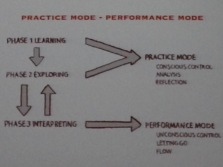
This is one of Inekes exercises:
Ask the singer to read (not sing!) the lyrics of the song in 2 tempi:
– As fast as possible
– Very slowly, combined with breaks now and then
It’s very interesting to witness how the expressed emotion automatically changes. You can do the same with breathiness, legato vs. staccato, and so on
Dana Indane – Free contemporary improvisation for singers
 Improvisation is still a challenge for me, so there were some butterflies in my stomach when I decided to participate actively in this workshop. Dana Indane shared with us her pedagogical tools, in which she asks the singers to combine their analytical mind with their intuition, in order to end up with a very individual style. We were divided into two groups and given several tasks. It was striking how fast people connected through these simple exercises, and how beautiful the result was. Dana truly managed to reach her goal of combining therapy and wellbeing with art. I left the room with a big smile on my face, as did a lot of my colleagues.
Improvisation is still a challenge for me, so there were some butterflies in my stomach when I decided to participate actively in this workshop. Dana Indane shared with us her pedagogical tools, in which she asks the singers to combine their analytical mind with their intuition, in order to end up with a very individual style. We were divided into two groups and given several tasks. It was striking how fast people connected through these simple exercises, and how beautiful the result was. Dana truly managed to reach her goal of combining therapy and wellbeing with art. I left the room with a big smile on my face, as did a lot of my colleagues.
Nana Fagerberg & Sophie Ziedoy – The Body Instrument
Nana Fagerberg and Sophie Ziedoy have studied at the Anne Rosing Institute. They introduced us to her method, which is built around the ‘Body Instrument’, the breath support and the vocal onset. This workshop focused on The Body Instrument.
 These are the 6 visual characterstics:
These are the 6 visual characterstics:
– No or a minimal arch in the lower back
– A wide back of the ribcage
– A lowered collarbone
– A deep ribcage from back to front
– A wide and open front of the ribcage
– No or minimal arch in the neck
Being a big fan of bodywork for the singer, I again participated actively in this workshop. I recognized a lot of exercises like the gorilla position, power poses, tree poses, and so on, which mostly worked on inhalation and breath support. I have to admit that even though I liked a lot of them, I didn’t agree with some of their ideas and exercises, as they felt uncomfortable on my voice. But then again, we all came to this conference to share and discuss. We can’t agree on everything ;o)
SATURDAY JUNE 20TH
Ineke Vandoorn – Warm-u
This warm-up was really fun, but I have to admit
that it was also quite challenging… Singing a jazz song now and then doesn’t make you a jazz singer ;o) Ineke warmed-up our voices and brains with surprising riffs and licks that were built around scales and chords that I don’t use every day. Luckily the faces of my colleagues told me that I was not the only one having to be very concentrated in order to be able follow. the exercises were taken from books of Bob Stoloff, Ann Peckam and Judy Niemack. Alert and a tiny bit proud of myself that I had managed to sing along, I entered the main hall for the following lectures.
Dr. Boris Kleber – Do we feel what we hear? The neuroscience of singing from a kinesthetic perspective
Oh, what a mesmerizing part of our body the brain is! The lecture of dr. Boris Kleber fed the nerdy part of me abundantly ;o) He started out by explaining the auditory-motor development.


Intended vocal production -> Motor command -> Auditory feedback -> ‘Do intention and production match? -> Adaptation of motor plans -> Adapted motor commands -> Auditory feedbak -> ‘Do intention and production match? -> …
This also explains the speech motor development of a child, which lasts 14 years.
 His research shows that trained singers process bodily information (kinesthetic sensation) differently from non-singers, as they have more brain-structure for sensory feedback processing. Their brain is specialized in integrating sensory stimuli. When you sedate trained singers, and thus lower the kinesthetic feedforward and feedback, they will sing considerably less well. But when you make sure they can’t hear themselves, and thus eliminate the auditory feedback, there will only be a minor difference. This means that for trained singers, the kinesthetic feedforward and feedback is more important than the auditory feedback. On the other hand, the performance of non-singers doesn’t get much worse after lowering the kinesthetic feedforward and feedback. But when they don’t hear themselves, they sing much worse.
His research shows that trained singers process bodily information (kinesthetic sensation) differently from non-singers, as they have more brain-structure for sensory feedback processing. Their brain is specialized in integrating sensory stimuli. When you sedate trained singers, and thus lower the kinesthetic feedforward and feedback, they will sing considerably less well. But when you make sure they can’t hear themselves, and thus eliminate the auditory feedback, there will only be a minor difference. This means that for trained singers, the kinesthetic feedforward and feedback is more important than the auditory feedback. On the other hand, the performance of non-singers doesn’t get much worse after lowering the kinesthetic feedforward and feedback. But when they don’t hear themselves, they sing much worse.
 I personally find this a particularly interesting way to explain to my students why they need to trust their sensation much more than what they hear through the PA. Oh, what a familiar situation it is, having to sing through a crappy PA, or having a ‘soundguy’ that for example apparently doesn’t know the difference between volume and gain.
I personally find this a particularly interesting way to explain to my students why they need to trust their sensation much more than what they hear through the PA. Oh, what a familiar situation it is, having to sing through a crappy PA, or having a ‘soundguy’ that for example apparently doesn’t know the difference between volume and gain.
But most importantly, this proves that training to be a singer changes your brain, as it changes the relative importance of auditory (less important) & somatosensory feedback (more important)! How exciting it would be, if we could combine vocal coaching with neural enhancement… Would we be able to teach our students more rapidly and effectively?
Janis Kudins – Latvian Vocal Music
The lecture of Janis Kudins was an interesting overview of the vocal music of Latvia. I had expected mainly folk music as I know it in my own country, but apparently in Latvia, opera is a big part of folk music. I was completely blown away by the trailer of War Sum Up by Hotel Pro Forma. If they would ever come to Belgium, I would be the first one to buy a ticket!
Elizabeth Aubry – Mirror mirror on the wall, who is the best voice teacher of them all? Self awareness for the voice teacher
 This title really triggered me and a lot of my colleagues, obviously… Nobody jumped up and shouted ‘Me, me, me!’, though ;o) I absolutely loved the message ànd the way Elizabeth Aubry presented it. Here are some quotes in order to give you an idea.
This title really triggered me and a lot of my colleagues, obviously… Nobody jumped up and shouted ‘Me, me, me!’, though ;o) I absolutely loved the message ànd the way Elizabeth Aubry presented it. Here are some quotes in order to give you an idea.
‘Studying the vocal function can help to clarify, correct and confirm what we already do instinctively.’
‘Recognizing and experiencing our own emotions, we can guide the student to perceive, accept and express his own.’
‘The best voice teacher has a clear sense of his / her identity, which is formed by several aspects: Life experience, where we come from, our family & culture, the roles we play in life and everything we have done, for good and ill, and all that has been done to us.’
‘If I live and teach with integrity and with a clear sense of who I am, I will be an example to my students as they develop their own sense of identity and integrity.’
‘Be a first class version of yourself, not a second class version of someone else.’ (Judy Garland)
Hannah Fahey – The singers voice: Rehearse, record, reflect and write
I personally videorecord every coaching
session for my singers and deliver it to them via Dropbox. It’s not only a service I pay to them, but also to myself, because they progress so much faster, which is nice for me too. I urge them to watch the video attentively and take notes afterwards. Just watching the video alone, makes the neuronal connections stronger, even if they don’t repeat the exercises. When you don’t take notes from a lecture or lesson, you remember only 10% of it… If you’re lucky. Taking notes during the lesson is time consuming and also stops the flow. So, there are only advantages! Once the singer succeeds in getting over the idea of ‘God is watching me’ with the camera ;o)
When singers feels insecure about the way they study, I ask them to make a ‘study diary’ and write down the answers to these 2 questions every time they study.
– Before: What is my goal and what’s my strategy in order to reach it?
– After: How did the session go and what are my thoughts on it?
This might for example bring to light that the singer tends to avoid ‘the hot potato’ and only sings the parts he / she already knows well. Because it’s much more fun. You can compare it to a diet diary that brings to light that you actually don’t eat as healthy as you thought ;o)
Hannah Fahey presented her own ideas on this and I agree 100% with her. Documenting creates reflexive, responsible practitioners. The communicable texts enhance the dialogue between the teacher, the student and peers. The singer learns descriptive language, ends up with an archive of developmental data for future use and he / she fosters an interest in pedagogy and research.
Astrid Vang Pedersen – Icebreaker
&
Jim Dhaus Hjernoe – Intelligent choir, an innovative methodology to empower conductors & singers in rock / pop / jazz / vocal music
 Oh, how much I have looked forward to the workshops of Astrid Vang Pedersen and Jim Dhaus Hjernoe. I have been blown away by the concept and attained results of the Intelligent Choir for the first time at the 3rd session of LeoSings (Tours, October ’14), and a second time at the 4th session in Freiburg (March ’15). My personal report on LeoSings4 is still in the making, but for now, you can watch this video, which reports on all sessions of LeoSings. LeoSings4 starts at 03.46.
Oh, how much I have looked forward to the workshops of Astrid Vang Pedersen and Jim Dhaus Hjernoe. I have been blown away by the concept and attained results of the Intelligent Choir for the first time at the 3rd session of LeoSings (Tours, October ’14), and a second time at the 4th session in Freiburg (March ’15). My personal report on LeoSings4 is still in the making, but for now, you can watch this video, which reports on all sessions of LeoSings. LeoSings4 starts at 03.46.
When working with this method, the music is divided into 4 main areas: Time & Groove, Intonation & Pitch, Sound & Blend and Expression & Interpretation. Afterwards, you can add Performance & Concert Design, which is a specialization of Astrid. The Intelligent Choir concept embodies quite a lot of voice painting (based on soundpainting by Walter Thompson), improvisation and circle singing in order to develop the skills and expand the comfort zone for every singer. You can read more on it in this presentation that Jim gave at LeoSings1 in Aalborg. Start at page 13.
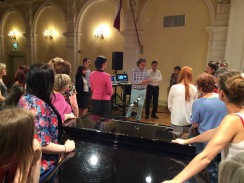 Astrid was responsible for the icebreaker. The exercises did exactly what the title promised to do: They broke the ice, so everybody was energetic, awake, in a positive mood, enthusiastic and up for the work with Jim (with the whole group together). This is one exercise: Two people stand in front of each other. You count to three over and over again, alternating between each other. Then you make all kinds of variations with clapping the hands and stamping the feet. Clap – 2 – 3 – Clap – 2 – 3 – … or 1 – Stamp – 3 – 1 – Stamp – 3 – … Oh yes, it may sound easy, but I can assure you it always ends in hilarious situations!
Astrid was responsible for the icebreaker. The exercises did exactly what the title promised to do: They broke the ice, so everybody was energetic, awake, in a positive mood, enthusiastic and up for the work with Jim (with the whole group together). This is one exercise: Two people stand in front of each other. You count to three over and over again, alternating between each other. Then you make all kinds of variations with clapping the hands and stamping the feet. Clap – 2 – 3 – Clap – 2 – 3 – … or 1 – Stamp – 3 – 1 – Stamp – 3 – … Oh yes, it may sound easy, but I can assure you it always ends in hilarious situations!
I have decided not to take notes during the workshop of Jim, in order to be able to experience it 100%, but you can watch this video about LeoSings2 in Aalborg, in order to get an idea of what we have done and how it works. As you can see, it is fun, fun, fun! The goal is to prepare the choir for the performance. And yes, we were prepared! Too bad we didn’t go on having a performance ;o)
Isabella Jezowska – Voice release through movement
 Voice and movement, they go hand in hand. Here you can find some beautiful classical examples. Isabella Jezowska is writing a book on how areal yoga (yoga in a hammock)
Voice and movement, they go hand in hand. Here you can find some beautiful classical examples. Isabella Jezowska is writing a book on how areal yoga (yoga in a hammock)
can help during voice training.
She states that  as the voice is a mechanical wave, it needs to be mechanically influenced. Movement has a direct influence on modulation and articulation. She works on pitch, the position of the vowels, dynamics and articulation, but the main focus is breathing and breath support. The exercises are divided into three parts: a warm-up, the fundamental part and the relaxation part afterwards.
as the voice is a mechanical wave, it needs to be mechanically influenced. Movement has a direct influence on modulation and articulation. She works on pitch, the position of the vowels, dynamics and articulation, but the main focus is breathing and breath support. The exercises are divided into three parts: a warm-up, the fundamental part and the relaxation part afterwards.
 As there were no yoga hammocks in the room, Isabella showed us a few exercises which demonstrated some of her goals. Even though I didn’t agree with some of the exercises – For example, I don’t believe in pushing the belly out during inhalation and breath support, I am curious for the results that Isabella presented as being amazing. Her lecture was unfortunately quite hasty, but also confusing, something I dedicate to the fact that she is still in the process of writing her book. I’m looking forward to the publication in 2016 and in the meanwhile, I’m starting areal yoga classes myself in September. A fortunate coincidence ;o)
As there were no yoga hammocks in the room, Isabella showed us a few exercises which demonstrated some of her goals. Even though I didn’t agree with some of the exercises – For example, I don’t believe in pushing the belly out during inhalation and breath support, I am curious for the results that Isabella presented as being amazing. Her lecture was unfortunately quite hasty, but also confusing, something I dedicate to the fact that she is still in the process of writing her book. I’m looking forward to the publication in 2016 and in the meanwhile, I’m starting areal yoga classes myself in September. A fortunate coincidence ;o)
Jaana Turunen – Group singing education for beginners
Jaana Turunen gave a beautiful lecture on the dangers of testing singers through auditions. We loose much too much potential, as we test too early, before every potential has been developed. We need to give musical education to everybody, without testing. I agree 100%. Read this quote on how singing in a group can help people who suffer from a lack of confidence.
Singing is not a mystery nor science impossible to understand and every singer starts a a beginner.
Janine Magnin – I like to sing: Scaffolding performance learning around the school pupils self motivation
Janine Magnin presented her research on the aspects that motivate children to take singing lessons. I have to admit that I didn’t understand a lot of the presentation… The main idea that entered my mind, is that HOW we present something is often much more important than WHAT we present, because even though I find this subject quite interesting, I have no idea what to report on it…
Marina Bizjak – Do we realize the importance of vocal technique in adolescence?
The lecture of Marina Bizjak explained why I have chosen not to coach singers younger than 15. It is a very specific field of work that I just am not specialized in. Let the cobbler stick to his last ;o)
The most important physical changes that a voice goes through happen between the age of 9 and 14, due to testosterone and estrogen. The vocal mechanisms like the larynx, laryngeal skeleton, lung function, vocal tract and thorax grow a lot. The indicators of these changes that are happening are hoarseness, huskiness, cracking, lowering / insecurity of pitch, decreased or inconsistent range and register breaks. Obviously, there is a significant difference between girls and boys.
Exercises need to be adapted to the personal situation and needs of the young singer. The focus needs to be on relaxation, posture, breathing coordination and vocalizing.
The End
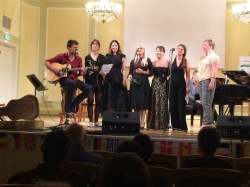 Eurovox ended with a presentation of ICVT 2017, the International Congress of Voice Teachers, which will take place in Stockholm, Sweden Augustus 2nd – 6th 2017 (Everybody, head over there!), a lovely concert by the singers of the YPP program and a celebration of Midsummer Solstice. Click here to see the pictures of this magical event, where we even made our own flower crowns. The evening ended with everybody dancing around the fire, chanting folk songs from their own country. Thank you so much, EVTA and Antra Jankava in special, for a very inspiring conference which ended with a big climax like I have never experienced during a conference before!
Eurovox ended with a presentation of ICVT 2017, the International Congress of Voice Teachers, which will take place in Stockholm, Sweden Augustus 2nd – 6th 2017 (Everybody, head over there!), a lovely concert by the singers of the YPP program and a celebration of Midsummer Solstice. Click here to see the pictures of this magical event, where we even made our own flower crowns. The evening ended with everybody dancing around the fire, chanting folk songs from their own country. Thank you so much, EVTA and Antra Jankava in special, for a very inspiring conference which ended with a big climax like I have never experienced during a conference before!
Also a big thank you to my wonderful colleagues for sharing their pictures. This report could not have been as colorful without them!


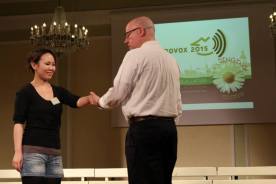


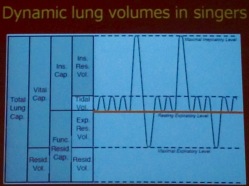

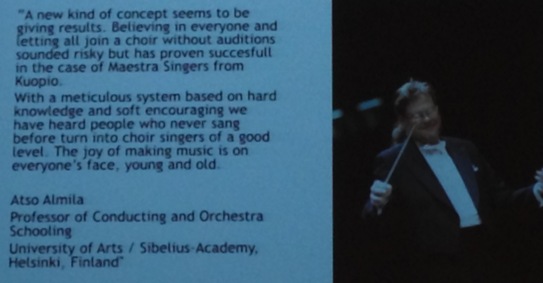



What a fantastic report Sarah! You are brilliant!!!
LikeLike
Thank you, dear Susan! It was such a wonderful experience. I’m thankful for having been able to be there 🙂
LikeLike